One of my favourite sayings is “learn from the mistakes of others” It describes my approach to competitor analysis perfectly. I love figuring out what my rivals did wrong so I don’t walk into the same wall. And, of course, it’s always nice to learn what they did right to incorporate those ideas into my own marketing strategy.
However, looking at your rivals’ SEO ups and downs without any context won’t help you make the right decisions. That being said, I believe that context is key when analyzing your competitors.

It is well worth spending the time on beforehand research to get a full picture of the competition level. That will help you tweaking your SEO strategy to start getting more traffic from organic results, scale your business, and establish the right SEO goals.
3 Big reasons why you need to care about your niche competitor analysis
Sure, of course, you need to know who you are competing against. But do you really need that much detail and extra work? The answer is yes. Especially, if your business spans across multiple geographies. Depending on your location, you might be fighting different battles. Knowing the ins and outs of your rivals will help you come up with the winning strategy and there are many reasons for that. To illustrate my point, let’s take a look at an example.
Reason 1: Country-level and geo-specific competition could be very different
Today there are tons of companies selling all around the globe. And in every single country, they have a unique market they need to worry about. Why you may ask? Well, let’s imagine an online store that is selling sneakers across the UK. If the store decides to expand to the US, there is a chance it will face a very different competition there. So the team will be tasked to create a whole new marketing plan to compete on an unfamiliar battlefield.
What’s interesting is that it also happens when the expansion happens within the same country. For instance, based on Ahrefs data the main SEO competitors of a UK sneakers store footpatrol.com on a national level are the following sites:
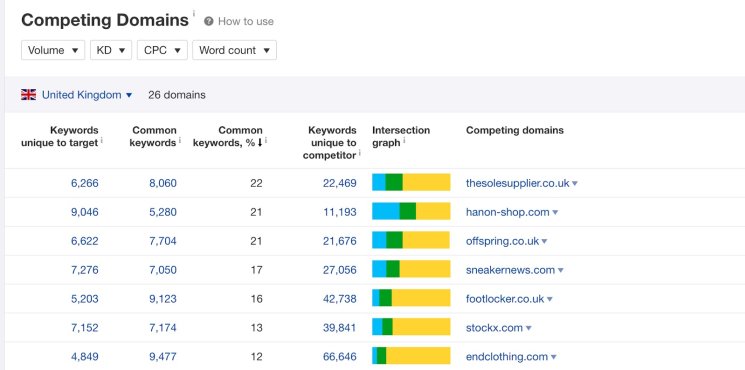
Now let’s analyze the rivals of the same store in London specifically.
To simplify things and don’t go too much into the weeds, I decided to run a quick check by using the keyword “air max sale” that has over 3000 monthly searches and has a pure commercial search intent.
Here’s a list of sites that appear to my search query for London:

As you can see, the sites that Ahrefs listed as organic competitors in the UK do not match the ones strictly in London. Why does it matter? Well, if you are trying to boost your national sales while competing against your London competition you might not get too far. That is why it is key to know who you are really up against. Don’t forget that local competition might be full of neighbourhood businesses with a strong marketing position that only operates in a very particular area.
For example, below you can see Google local packs in London vs in Leeds for sneaker stores:

London local pack
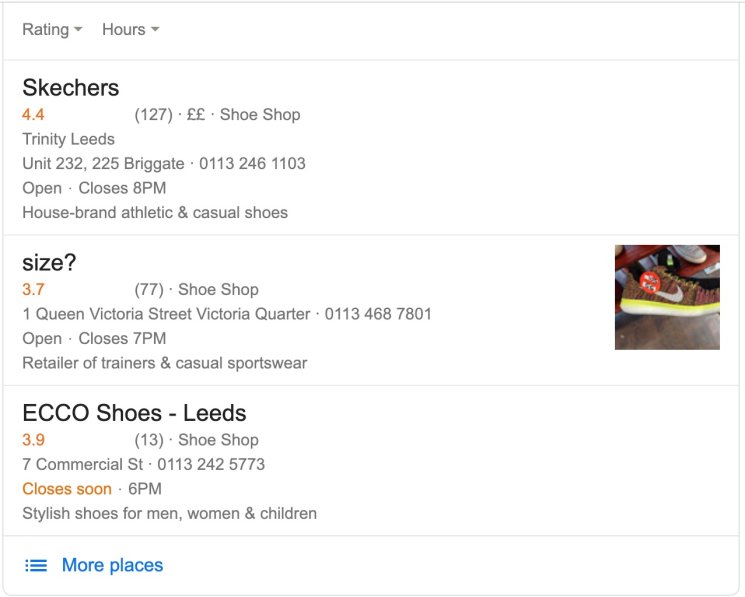
Leeds local pack
Check for businesses that show up in Google local packs when you are searching for your keywords. The results vary based on the location as they only show stores in that particular area and some of those physical stores typically also sell online. If you want to run a quick check for a particular search query then here’s a free tool from AccuRanker that allows seeing Google SERPs across nearly each and every location.
Reason 2: Pick your keywords wisely to rank high in categories with a lower competition level
Careful competitor analysis can help you set realistic and achievable goals for your marketing strategy. Make sure to check the level of competition in SERPs across relevant products to see where you can have a breakthrough and rank high. I hate to say this, but if you are trying to compete against gigantic e-commerce stores like Amazon your chances are pretty slim, to put it nicely. Instead of dumping efforts into impossibles, focus on goals that can help you grow organic traffic.
To give you some context, tools like SEMrush are great when it comes to evaluating the competition. SEMrush can do it by nearly any set of keywords for over 100 countries on a fly. But sadly, there’s a huge limitation as there’s no way to do it based on a selected by your location. However, checking the level of competition in particular locations, which can be done with the help of AccuRanker tool, is totally worth your time. Let me show you why by looking at SEMrush analytics.
Imagine, we are still interested in selling sneakers. I decided to take Nike air max products as an example of sneakers. Here’s how difficult it’s going to get to the top positions in the UK:
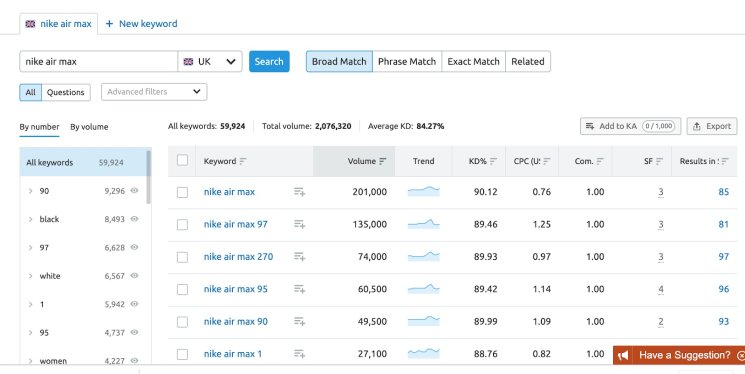
As we can see, to rank high will be nearly impossible as everything that goes over 70% has an insane level of competition. With this quick exercise, we learned that the keywords we picked are too competitive and we will be better off going for something else. However, pay attention that the uncovered level of competition is on a country level and it might or might not correlate with a geo-specific one.
Reason 3: You want to expand your business and want to build a competition heatmap for your go-to locations
If you want to succeed in SEO you need to understand what kind of sites are currently ranking by your top commercial keywords and whether it’s possible to end up being in the top 3 results.
You are probably familiar with a heatmap term that is widely used by CRO and UX experts. It is a great way to see how users interact with your website. Services like Hotjar, Smartlook can create beautiful heatmaps of your page highlighting areas that get the most clicks and attention.
You can take this idea and use it for your competitor analysis. The more competitive a location is the more vibrant the colour. Visualizing data helps see a bigger picture and get an at-a-glance view and there are tons of ways to do it besides heatmaps.
So those are the 3 top reasons why knowing your niche competitors is essential. Hopefully, now you can’t wait to identify all your rivals. Perfect! So let me show you the nitty-gritty of doing that with the AccuRanker.
A step-by-step process of niche competitor analysis
I’m a big fan of a practical approach. So I decided to share my “how-to”s of competitor analysis for you to try and see how useful it can be. A thing to keep in mind is that this process can’t be done overnight especially if you want to look at many rivals. However, I do promise that this analysis is extremely valuable and will not be a waste of your time. Now if you’re ready, let’s dive in!
How-tos of uncovering your competitors:
Step 1: Gather a list of relevant keywords
As with nearly all SEO processes, everything starts with keywords. They are an indicator of market demand in digital marketing – the more users are searching for a particular keyword the more potential buyers are out there.
Oh, and don’t forget about the search intent behind the keywords! Some searches are only informational, meaning that the users are not looking to buy just yet. There is actually a lot of recent research on the intent behind search queries. For example, Google started to determine the connections between some keywords with the help of semantic search and as a result, your page can rank for a broader keyword that is not part of your page’s content.
However, if you have an established business process that has a solid number of customers then it might make sense to focus on the keywords that you know for a fact are getting the most significant traffic and conversions.
It’s quite easy to get a list of such search terms if you connect your Google Search Console to Google Analytics.
Tip: Keep in mind Accuranker integrates with Google search console and can automatically pull your keywords during the setup process.
In case you’re working on a marketing plan for a specific geography, it makes sense to only export search queries that are bringing you traffic and conversions in that area.
If you want to explore new products/services that haven’t yet started to get traffic then you need to do keyword research. There are tons of keyword research tools out there but among my fav is KwFinder as it gives you the biggest number of options: auto-suggested keywords, related search terms, and questions:
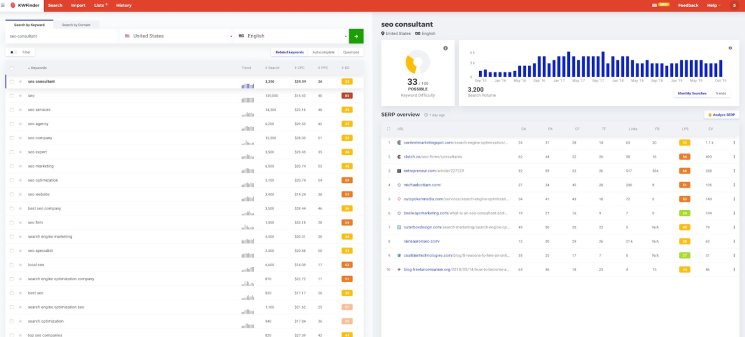
This tool is extremely helpful as it suggests what keywords would be a great start for your SEO if you are just beginning. And later you can always analyze their performance and tweak it to fit your strategy.
Another thing to look into is the kind of rival pages that are getting the highest number of organic visitors. Focus on the pages that include names of relevant to your products/services in their URLs. SEMrush allows you to see the list of pages with the most organic visitors and then add a filter to get only applicable to you pages:
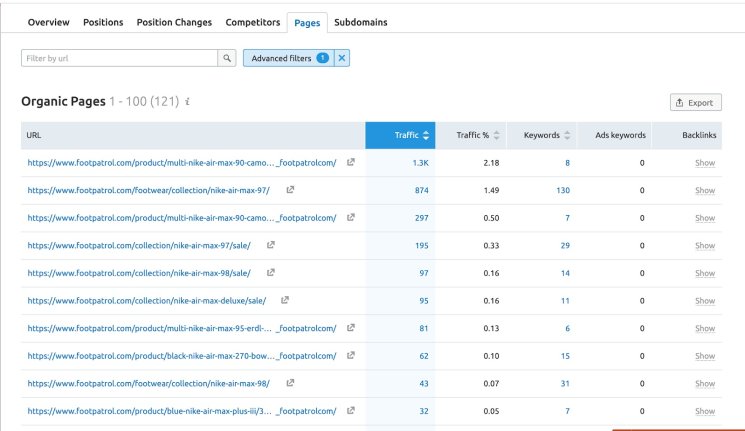
By checking out those pages you can get an idea of the keywords that bring your competitors the most success. If you want to dig even further, SEMrush has other awesome features that I would really recommend exploring.
- Step 2: Create a campaign in the AccuRanker
Alright, you have a list of your keywords. Now it’s time to go to the AccuRanker and set up a campaign with as many geo targets as you’d like. That’s a unique feature that not all position tracking tools offer. Most of the rank trackers force you to create a separate campaign for each location which is not fun at all!
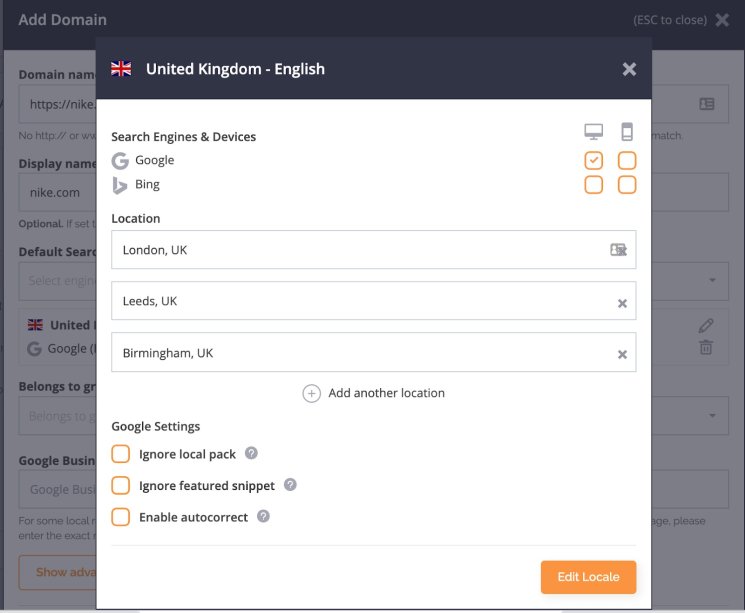
To take your analysis even further, I would recommend adding tags to your most important keywords in a CSV file. Make sure to add a geo-specific level of detail to the file to filter out areas you are not currently focused on. Here’s how exactly your CSV file should look like to ensure that it’ll be processed by AccuRanker correctly:
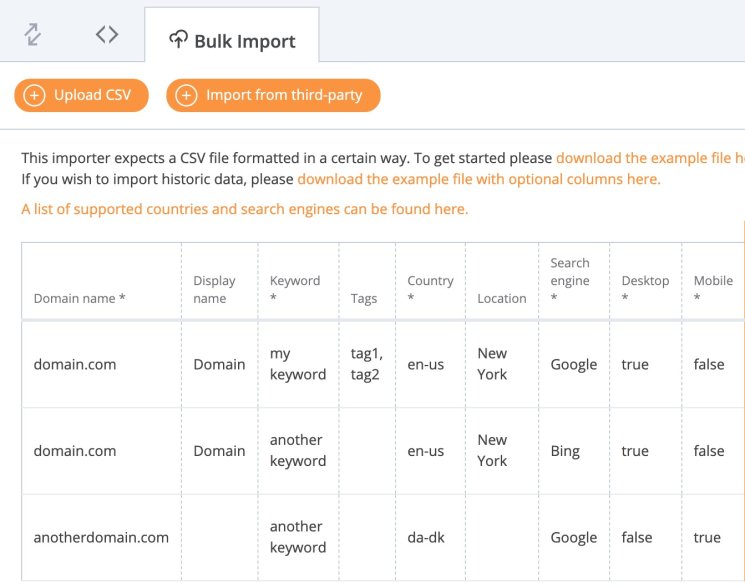
- Step 3: Analyze sites that are currently ranking in top results
What’s great about AccuRanker is that it only takes a couple of minutes to start getting results after your campaign is initiated. To check how well your national competitors are ranking across a selected area, simply filter out particular locations.
To check how well your national competitors are ranking across a selected area, simply filter out particular locations. If you are unsure who you are truly competing against, you can use AccuRanker competitor’s discovery feature to find sites that are ranking high in your keywords in Google. For example, this is how I found fightclub.com that has solid visibility:

- Step 4: Evaluate the level of competition based on what you’ve uncovered by looking at the following metrics:
1. Share of traffic across selected search queries
AccuRanker will automatically build your competitive landscape based on selected filters. Those filters could include particular locations or keywords that you previously labelled via tags in your CSV file. Below is how a competitive landscape looks like for stockx.com site for keywords that are related to Yeezy 700 sneakers:
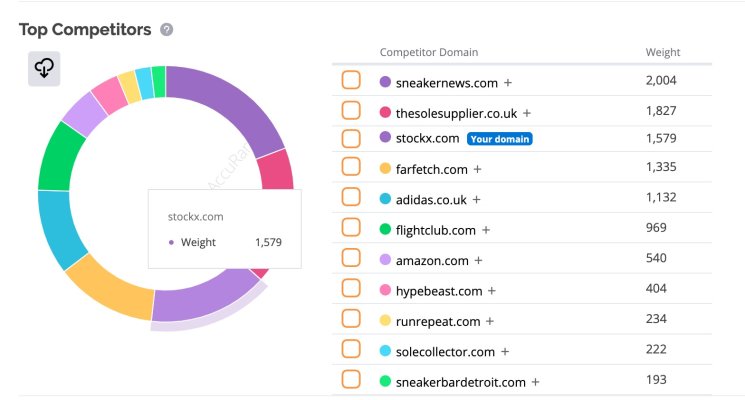
As you can see, there are many heavy hitters like Amazon and Adidas. And it’s quite interesting to see that among e-commerce stores the biggest portion of visibility goes to a site that doesn’t sell sneakers at all. Truth to be told, it is pretty common. News sites or blogs can easily outrank e-commerce stores and link building plays a big role in this phenomenon. Content pages are outranking e-commerce stores because people are more likely to link to an interesting content page rather than to a commercial page. And that’s where we’re moving on to the next metric that you should check – the number of referring domains. 2. How many referring domains they own and whether they’re actively building links
Ahrefs is the best tool when it comes to analyzing websites backlink profiles. Start your research by simply checking the trend of referring domains’ growth. This metric will tell you if there were any spikes in terms of the number of linked domains. For instance, on a screenshot below you can see that sneakernews.com had some growth of referring domains but this growth looks like quite a natural one:
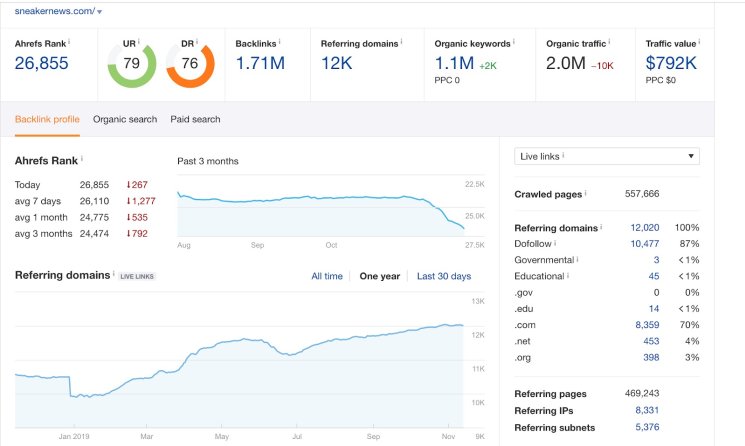
To get a clear answer whether a site is investing in link building is pretty easy. You need to get a list of pages that have links. In Ahrefs this report is called “Best by links”. And that’s what you’ll get:
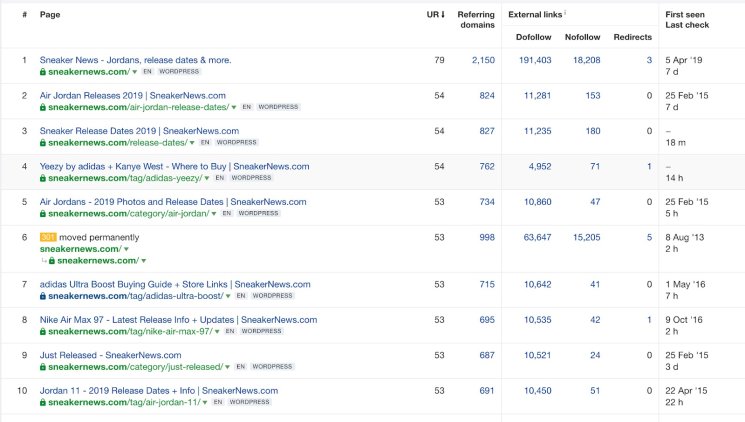
Let’s take a closer look at the results. Looks like category pages have the highest number of links. Well, typically, people don’t link to those pages since there is usually nothing worth sharing across your social media. So it is a clear sign that those guys are heavily geared towards link building. For you, it means that you won’t be able to outrank them if you’re not ready to spend a lot of time and effort to build links. 3. How successful their content is in terms of traffic
One more thing to check for is whether the uncovered rivals are running blogs or any other form of content. This will help you decide if you need to start blogging too and how to structure the content and promotion.
What do I mean by structuring your content and promotion? So in some industries, key players have insanely high competition in SERPs. To compete with them you would need to focus on acquiring links back to your blog pages rather than producing new posts. Learning information like this is extremely helpful since it will help you put your money and efforts into where it will give you the best results.
Note: if you do realize that you need to start running a blog – do it well. There are a lot of company blogs that are simply a dead weight as the companies have no idea how to correctly promote them. So make sure to audit your own blog from time to time to see if you are still aligned with your SEO strategy and your blog is engaging and exciting.
Going back to looking into competitors’ blogs, a combination of BuzzSumo and Ahrefs will help you understand how well the posts are distributed and how great their SEO performance is. In the BuzzSumo Content Analyzer report, you could set up filters that will include the date when content was published as well as its’ length. I use a length filter mostly because it helps filter out non-content pages. Here’s a screenshot showing that stockx.com has tons of blog posts that only have a few social shares and acquired links:
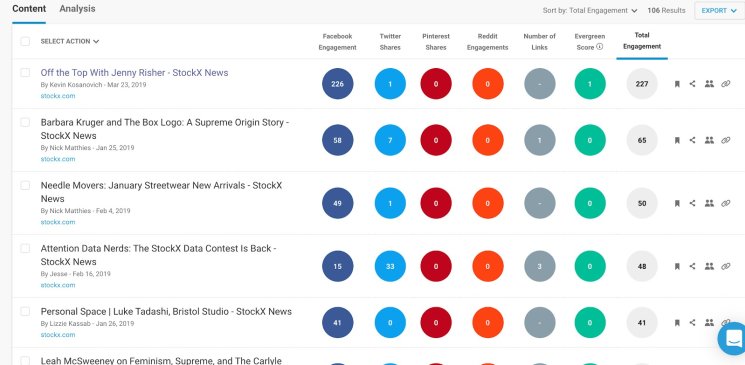
Once you have a list of content pages you could move to Ahrefs Batch Analysis tool to check their monthly organic traffic. The following table will show you organic traffic for the pages:
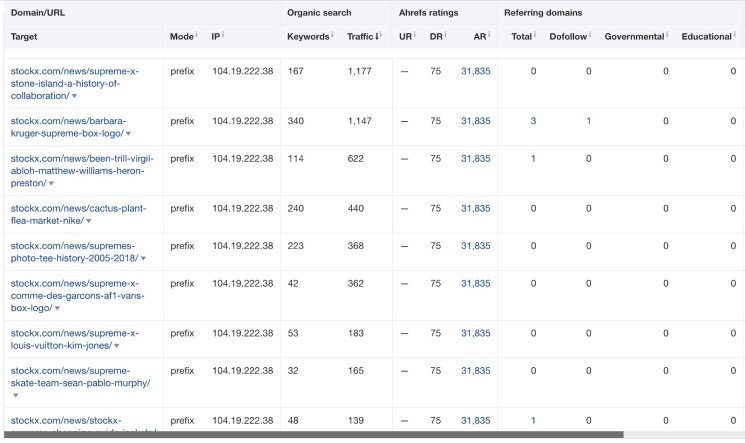
Only a few of the stocx.com blog posts are getting a decent flow of organic visitors. So if I was to compete against them, I would follow the path “less is more” and focus on building links rather than content creation. They really don’t have that many links so outranking their content pages will be pretty simple if your domain rating is close to theirs.
This is where I hand the reins over to you.
As you can see, niche competitor analysis is not that simple. It has a lot of nuances and things to keep in mind. But, hopefully, after reading this post you see how valuable it can be especially when crafting your SEO strategy. I tried to give you a good overview of how to find your rivals and learn their tricks of the trade but, of course, it is impossible to cover all of them in just one post. I would really encourage you to explore the tools mentioned earlier and see what metrics will be most relevant to your analysis.
Final tip: Once you play around with the tools and collect all the data you find important, you can create a glowing presentation using beautiful templates from Venngage guys. I am sure your boss will be impressed with all the work you will have done and will be as excited about the SEO Strategy for the next year as you are.
Let’s talk & work together
Whether through my agency or as an independent consultant, I am here to help your business or project succeed.
Related articles
Stay updated!
Subscribe to get latest news, insights, technology, and updates.
" " indicates required fields




